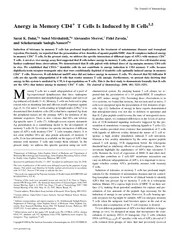/


Dalai Saied Mirshahidi Alexandre Morrot Fidel Zavala and Scheherazade SadeghNasseri Induction of tolerance in memory T cells has profound implications in the treatment of autoimmune diseases and transplant rejection Previously we reported that the ID: 56168
Download Pdf The PPT/PDF document "Anergy in Memory CD T Cells Is Induced b..." is the property of its rightful owner. Permission is granted to download and print the materials on this web site for personal, non-commercial use only, and to display it on your personal computer provided you do not modify the materials and that you retain all copyright notices contained in the materials. By downloading content from our website, you accept the terms of this agreement.
AnergyinMemoryCD4TCellsIsInducedbyBCellsSaratK.Dalai,*SaiedMirshahidi,*AlexandreMorrot,FidelZavala,andScheherazadeSadegh-NasseriInductionoftoleranceinmemoryTcellshasprofoundimplicationsinthetreatmentofautoimmunediseasesandtransplantrejection.Previously,wereportedthatthepresentationoflowdensitiesofagonistpeptide/MHCclassIIcomplexesinducedanergyinmemoryCD4Tcells.Inthepresentstudy,weaddressthespeci cinteractionofdifferenttypesofAPCswithmemoryCD4 *DepartmentofPathology,JohnsHopkinsSchoolofMedicineandDepartmentof differentdosesofcOVA.WedemonstratethatanergyisinducedinmemoryTcellsexvivowhenBcellspresentedtheAgatacertainrangeoflowpeptidedoses.Further,wevalidatedthis ndinginvivobydemonstratingthattransferringrestingBcellspulsedwithlowdosesofpeptidetomicebearingmemoryCD4Tcellsinducedanergy.WeruledoutaroleforCD11corotherDCsintheinductionofanergyinmemoryTcells.ConsistentwiththeroleforrestingBcellsexpressinglowlevelsofB7-1intheinductionofanergy,weshowedthatanergyinthissystemisreg-ulatedbyCTLA-4.MaterialsandMethodsTCRTgmice(DO11.10)thatexpressTCRrecognizinganI-AstrictedcOVAonBALB/cbackgroundwereusedasthesourceofTcells.Non-TgfemaleBALB/cmiceandC57BL/6(B6)miceat56wkofage,TgfemaleDO11.10andOTIImice,andcell-de cientmuMTmicewereallpurchasedfromTheJacksonLaboratory.Diphtheriatoxinreceptor(DTR)TgmiceonBALB/cbackgroundwerebredwithnon-TgBALB/cmice,andtheheterozygousoffspringforDTRwereusedforthestudy.AllmicewerehousedintheJohnsHopkinsUniversityanimalfacilities(Bal-timore,MD)undervirus-freeconditions.AllexperimentswereperformedinaccordancewithprotocolsapprovedbytheAnimalCareandUseCom-mitteeoftheJohnsHopkinsUniversitySchoolofMedicine.PeptidesandAbsThepeptidecOVA(ISQAVHAAHAEINEAGR)wassynthesizedbyGlobal-PeptideServices.Thepeptidewas90%pureasanalyzedbyre-verse-phaseHPLC.FluorescentlylabeledAbstomouseCD4,CD25,CD44,CD45RB,CD62L,CD69,CD45R(B220),CD19,CD11c,IL-2,,anti-mouseCTLA-4,CD80(B7.1),andCD86(B7.2)werepur-chasedfromBDPharmingen;theAbtoclonotypicTCR(KJ1.26)speci cforDO11.10CD4TcellswaspurchasedfromCaltagLaboratories;andanti-mouseCTLA-4Abwaspuri edfromtheculturesupernatantofhy-bridoma(UC10-4F10-11;AmericanTypeCultureCollection(ATCC)).AdoptivetransferandimmunizationsTgCD4Tcells(2.0cellspermouse),preparedfrompooledLNsandspleensofDO11.10mice,wereresuspendedin100lofsterilePBS(Invitrogen)andtransferredi.v.intoBALB/crecipients.Twodayslater,micewereimmunizeds.c.(atthebaseofthetail)with15nmolofcOVApeptideemulsi edinCFA.InductionofanergyincOVA-speci cmemoryCD4cellsinvivobyadministrationoflowdosesofpeptideinIFAFiveweekspostimmunization,toallowforthegenerationofmemoryTcells(veri edbystainingformemoryTcellmarkers;datanotshown),micewereinjecteds.c.withincreasingconcentrationsofcOVAtide(0.00550,000pmol)mixedwithIFA.Tendayslater,inguinalLNswereremovedandTcellswerechallengedinvitrowithcOVAtide.ProliferationwasmeasuredbyCFSEdilutionassay.Brie y,LNcellswerelabeledwith1MCFSEinPBSfor80satroomtemperatureandwashedtwicewithRPMI1640containing10%FCS.Cellswerecul-turedwithorwithoutpeptideat37Cfor72h.Followingtheculture,Tcellswerestainedwith uorescentlylabeledanti-mouseCD4AbandKJ1.26anticlonotypicTCRAbandanalyzedby owcytometry.Tcelldivisioninresponsetoinvitropeptidechallengewascalculatedasde-scribed(14)usingthefollowingformula:numberofevents()ateachcelldividedby2.Thepercentageoftotaldividingcellsnumberofcohortsundergoing16divisions/totalnumberofcohortsun-dergoing06divisions)IsolationofTcellsSpleensfrom5-wkpostimmunizedmicewereremovedandasingle-cellsuspensionwasmadeafterlysisofRBCsandusedasthesourceofTcells.Themicesacri cedforthispurposehadreceivedasingleimmunizationafteradoptivetransferofTcells.ByusinganR&DSystemsCD3enrich-mentcolumn,Tcellswereisolatedfromsplenocytes.TcellpuritywasIsolationofinvivopulsedAPCsForty-eighthoursafters.c.injectionofpeptideemulsi edinIFA,miceweresacri cedandinguinalLNswereremoved.ToseparatewholeAPCs,LNcellsweredepletedofTcellsbyusingeitherDynal-Thy1.2beadsorMACS-Thy1.2microbeads(MiltenyiBiotec)(95%depletion).ToisolateBcells,aMACSB220microbeadwasused(95%purity).ToobtainAPCsdevoidofBcells,LNcellsweredepletedofTandBcellsbyusingacombinationofThy1.2andB220microbeads(MACS).MACSCD43microbeadswereusedtopurifyB2Bcells.ToobtainAPCsdevoidofB2Bcells,LNcellsweredepletedofTcellsbyThy1.2microbeadsfollowedbypositiveselectionwithCD4microbeads(15).TheseAPCsaretermedinvivopulsedAPCsinthisstudy.InductionofanergyinmemoryCD4TcellsexvivobyinvivopulsedAPCsToinduceanergyinmemoryCD4Tcells,enrichedTcells(1wereincubatedwithinvivopulsedAPCs(irradiated,2000rad)ataratioof1:2for48hina96-wellplate.Totestforanergy,splenocytesfromnormalmicewerepulsedinvitrowithcOVApeptide,irradiated,andadded(2perwell)totriplicateculturewellsandincubatedfurtherfor72hbeforeadding[H]thymidineorfor10hbeforeassayingforintracellularcytokinesynthesis.Todeterminethepercentageofcellsmak-ingIL-2orIFN-,cellswerestainedwithAbstoCD4,clonotypicTCR(KJ1.26),andIL-2orIFN-andanalyzedby owcytometry.Duringdataanalysis,thequadrantsweredrawnbasedonthematchedisotypeAbcon-trols.ThepercentageofDO11.10cellsmakingIL-2orIFN-wascalcu-latedaftersubtractingthepercentageofDO11.10cellsstainedpositiveforthematchedisotypes.InductionofanergyinmemoryCD4TcellsexvivobyinvitropulsedBcells,DCs,oractivatedBcellsWefollowedthesameanergyprotocolasaboveexceptthatBcellsorDCswerepuri edfromthespleensofunimmunizedmicebyusingMACs-B220 FIGURE1.AdministrationofsuboptimaldosesofcOVAtideinIFAinducesanergyinspeci cmemoryCD4Tcellsinvivo.Eightgroupsofmice(threemicepergroup)bearingmemoryCD4Tcellswerechallengedwithincreasingdoses(0.00550,000pmol)ofcOVApeptideinIFA.Tendayslater,cellsfromdrainingLNswereharvestedandanergywasassayedbypeptiderechallengefor72hinvitro.Tcellpro-liferationwasmeasuredbyCFSEdilutionassayofAg-speci cKJ126Tcells.ThedosesfortheinvitrochallengewithcOVApeptidearerepresentedasfollows: lledblackhistogram,0M;thingrayline,0.1M;blackline,1M;thickgrayline,10M.Datashownrep-resentoneofthreeindependentexperiments.ThelowerpanelthepercentageofAg-speci ccells(DO11.10)dividedinresponsetoinvitrochallenge.3222BCELLSANERGIZEMEMORYCD4TCELLS forBcells(purity95%)orMACs-CD11cmicrobeadsforDCs(purity80%)andpulsedinvitrofor3hat37°CwiththecOVAbeforeincubatingwithmemoryTcells.ForactivatedBcells,puri edBcellswerestimulatedwithCpG(6g/ml)for24h(16)andwashedtwicebeforepulsingwithpeptide.NotethattheamountofpeptideforpulsingAPCsinvitrowascalculatedbasedonmolarpeptideconcentration,whereasthepeptidesgiventomicewereinmoleunits.InductionofanergyinmemoryTcellsinvivointheabsenceofBALB/cmiceexpressingDTRundertheCD11cpromoter(17)wereadop-tivelytransferredwithDO11.10TgTcells.Twodayslater,micewereimmunizeds.c.withcOVApeptideinCFA.After5wk,DCsweredepletedbymultipleinjectionsofdiphtheriatoxin(DT)(Sigma-Aldrich)duringtheinductionofanergyinvivointhesemice.Brie y,micewereinjectedi.p.with100ngofDTpermouse12hbeforetheinjectionofpeptideemulsi edinIFA.Then,micewereinjectedwiththesamedoseofDTtwicemore,at10and36hafterAgchallenge.SamplingofspleenandLNtissuesduringthetreatmentinaparallelsetofmicecon rmedthedepletionofDCsinDT-injectedmiceasdetectedbyselectiononCD11candGFP(expressedundertheCD11cpromoter),indicating0.2%DCsintheLNsofthosemice.Onday3(60hafterAginjection),miceweresacri cedandcellsharvestedfromthedrainingLNswerechallengedexvivowithcOVApeptidefor72h.InductionofanergyinAg-speci cTcellswasdeterminedbyCFSEdilutionassay.ThepercentageofAg-speci c(DO11.10)CD4Tcelldivisionsinresponsetoinvitropeptidechallengewascalculatedasdescribedabove.InductionofanergyinvivoinmemoryTcellsbyinvitropulsedBcellsBcellswerepuri edfromthespleensofunimmunizedmiceandpulsedinvitrowithincreasingamountsofcOVApeptide(0.000011000nM)for3hat37°C.Followingincubation,Bcells(notirradiated)werewashedtwicetoremoveexcesspeptideand10cells/mousewerei.v.transferredtoBALB/cmicebearingcOVA-speci cmemoryCD4Tcells.Tendayslater,miceweresacri ced,andcellsfromdrainingLNsandspleenswereharvested.InductionofanergyinAg-speci cTcellswasdeterminedbytheCFSEdilutionassayafterinvitrochallengewiththecOVApeptidefor72h.ThepercentageofAg-speci c(DO11.10)CD4Tcelldivisioninresponsetoinvitropeptidechallengewascalculatedasde-scribedabove.InductionofanergyinmemoryCD4TcellsinvitrobyinvivopulsedB2BcellsAllBcells,B2Bcells,orAPCsdevoidofB2BcellswereobtainedfromthedrainingLNsofmiceimmunized48hearlierwithpeptideinIFAandincubatedwithmemoryCD4Tcellsfor48h.InductionofanergywastestedbyrestimulatingTcellswithcOVApeptide-pulsedsplenocytesfor72h,followedby[H]thymidineincorporation.InductionofanergyinmemoryCD4TcellsinBcell-de cientmuMTmiceBecausemuMTmiceareonB6background,onlyforthisexperimentB6micewereusedasrecipientsandOT-IITgCD4Tcellsspeci cforwereusedforadoptivetransferandthegenerationofmemoryTcells.RecipientmicewereimmunizedwithcOVACFAfortheinductionofmemoryTcellsadayafterTcelltransferasdescribedpreviously.Intheexperimentsshown,memorycellswereiso-lated46moafterimmunization.CD4Tcells(7toincludeOT-IITcells)werethenpuri edandtransferredtomuMTmicebeforetheinjectionofAgforanergyinduction.B6micebearingmemoryOT-IIcellswerecalledBcell-suf cientmice.Allgroupsofmicewereimmu-nizeds.c.withcOVAinIFA.Ninedayslater,cellsfromdrainingLNswereharvestedandassayedforanergybytheirabilitytoproliferate FIGURE2.BcellsloadedwithlowdosesofAginduceanergyinmemoryCD4Tcellsexvivo.,Anergywasinducedinvivo(asdescribedinMaterialsandMethods).MicebearingmemoryCD4TcellsweregivencOVAinIFAfortheinductionofanergyand48hlaterdrainingLNswereharvestedandtestedforanergyinvitrousing[H]thymidineincorporation.,Anergywasinducedexvivo.MemoryTcellsisolated(APC-depletedTcells)frommiceimmunized5wkorlongerwereincubatedwithAPCpopulations(wholeLNcellsdepletedofTcells()orenrichedforBcells())isolatedfromBALB/cmicegivencOVAinIFA48hbeforethecellharvest.IsolatedAPCs(depletedofTcellsbyThy1.2microbeads)werepulsedwithdifferentdosesofpeptideasshownonthe-axis.MemoryTcellsandpulsedAPCswereincubatedfor48h.Culturedcellswereassayedfortheinductionofanergyduringthe rst48hofexvivoculturebytheadditionoffreshlypulsedsplenocytesat0,0.1,1.0,and10McOVAinvitroandcellproliferation()andIL-2()andIFN-production()weremeasured.Thedatashownrepresentoneofthreeindependentexperiments.BarsrepresentmeanSDoftriplicatecultures.0.005,5,or50pmolvs0.05or5000pmolofpeptidedoses(Studentstest).Therewere vemicepergroupandcellsfromtriplicatewellswerepooledbeforemeasuringIL-2andIFN-synthesis.CytokinesynthesiswasanalyzedonKJ1.26cellsgatedonCD4Tcells.TheJournalofImmunology andtomakeIL-2andIFN-usingthymidineincorporationandintracel-lularcytokineassays.Forthymidineincorporation,cellswerestimulatedwithpeptidefor72hfollowedbytheadditionof[H]thymidineandincubatedfor18hbeforeharvest.Forintracellularcytokinesynthesis,cellswerestimulatedwithpeptidefor5.5hinthepresenceofGolgiStop.OT-IIcellswerethenstainedwithAbstoCD4,V2,V5.1,V5.2,andIL-2or.Duringdataanalysis,thequadrantsweredrawnbasedonthematchedisotypeAbcontrols.ThepercentageofOT-IIcellsmakingIL-2orwascalculatedaftersubtractingthepercentageofOT-IIcellsstainedpositiveforthematchedisotypes.ExpressionofCTLA-4inmemoryCD4TcellsMemoryCD4TcellswereincubatedwithinvivopulsedAPCs(BcellsorAPCsdepletedofBcells)for48h.SurfaceexpressionofCTLA-4onTcellswasdeterminedby owcytometry.ThelevelofCTLA-4wasexpressedasCTLA-4index:mean uorescenceintensityfractionofcellspositiveforCTLA-4.ReversalofanergyinmemoryCD4Tcellsbyanti-CTLA-4MemoryCD4TcellswereincubatedwithinvivopulsedBcellsfor48hinthepresenceof10g/mlanti-mouseCTLA-4Ab(UC10-4F10-11;ATCC).AnergyorreversalwastestedbyrestimulatingTcellswithpeptide-pulsedsplenocytesfor72h,followedby[dineincorporation.StatisticalanalysesLevelofsigni cance(value)wasdeterminedbyusingunpairedStu-0.02wasconsideredsigni cant.speci cCD4Tcellsacquirememoryphenotype35dayspostprimingWehavepreviouslyshowntheinductionofanergyinmemoryCD4Tcellsinresponsetolowdoseantigenicchallengeintwoantigenicsystems(11).Toextendthose ndingstotheDO11.10Tgsystem(cOVAspeci c),DO11.10TgTcellsweretransferredintowild-typeBALB/cmice(18)and2dayslater,whichallowedthehomingoftransferredcellstothelymphoidorgans,recipientswereimmunizedwith15nmolofcOVAinCFA.Thirty- vedaysafterimmunization,thetimerequiredforthegenerationofmemoryTcells(11,19),splenocyteswerehar-vestedandDO11.10CD4Tcellswerestainedformemorymarkers.LevelsofCD25,CD44,CD45RB,CD62L,andCD69expres-sionwereanalyzedonCD4andKJ1.26doublepositivecellsandcomparedwiththelevelsonnaiveTcellsfromcontrolmicetreatedwithIFAorCFAalone.Byday35postimmunization,80%oftheCD4TcellsacquiredthememoryphenotypeasevidencedbyanincreasedlevelofCD44anddecreasedlevelsofCD45RBandCD62LexpressionontheircellsurfacesInvivoadministrationoflowdosesofpeptideinIFAinducesanergyincOVA-speci cmemoryCD4TcellsMicepreviouslyimmunizedwithcOVAforthegenerationofmemoryTcellswereadministereddifferentamountsofpeptideinIFA.After10days,cellsfromdrainingLNswerelabeledwithCFSEandCD4TcellswerestimulatedinvitrobyfreshAPCspulsedwithincreasingdosesofpeptidefor72h.TodetermineAg-speci ccellproliferation,CFSEdilutionanalysiswasdoneondoublepositivecellsby owcytometry.WefoundthatAg-speci cTcellsthathadencountered0.550pmolofpeptideinvivoremainedundivided,whereasTcellsfromthemiceimmunizedwithdosesbeloworabovethatrangedividedseveralcycles(Fig.1).ThestartingnumbersofCD4TcellswerecomparableinallofthegroupsofmiceimmunizedwithpeptideinIFA,indicatingthatTcellsarenotdeletedbutratherareanergized.Theseresultsextendtheapplicabilityofourprevious ndingstoanentirelynewantigenicsysteminwhichmemoryTcellscanbeanergizedbyarangeofsuboptimaldosesofAgs(11,12).ExvivoanergyassaytotestrolesfordifferentAPCsintheinductionofanergyinmemoryCD4TcellsDeterminingwhichAPCsuniquelyinteractwithmemoryTcellsinvivoisexperimentallychallenging.Tosimplifytheproblem,anexvivoassaywasdesignedtoevaluatethecontributionofdifferentAPCstotheinductionofanergyinCD4memoryTcells.WehypothesizedthatAPCsloadedinvivowithlowdosesofpeptidecouldanergizememoryTcellsexvivoinasimilarmannerastheydoinvivo.Totestthis,memoryTcellswereisolatedfrommice35dayspostimmunizationandcoincubatedwithAPCsfromthedrainingLNsofmicethathadbeenimmunizedwithincreasingdosesofpeptide(range05,000pmol)inIFA48hearlier.Cellswereculturedfor48handthentestedforanergyinductionuponstimulationwithsplenocytespulsedwith0,0.1,1,and10peptide.Fig.2isacontrolproliferationexperimentindicatingthatanergyisestablishedwithin48hinvivo.Fig.2,,depictresultsoftheexvivoassayindicatingtheproliferationofTcellsexposedtoAPCsfrommiceinjectedwithdifferentdosesofpep-tideinIFA.Theseexperimentsclearlyshowthatduringthe48-hexposuretoAPCs,memoryTcellsbecameanergicinresponseto FIGURE3.InvitropulsedBcellsinduceanergyinmemoryCD4cellsexvivo.EnrichedB220Bcells()orCD11cenrichedDCs(fromspleensof venormalBALB/cmicewerepulsedwiththeindicateddosesofcOVApeptidefor3h,incubatedwithmemoryCD4cellsfor48h,andtestedforanergyasdescribedinthelegendofFig.2using[H]thymidineincorporation.Datashownrepresentoneoffourindependentexperiments.BarsrepresentmeanSDoftriplicatecultures.0.001,0.15,or1.5nMvs0.0015or15,000nMpeptide3224BCELLSANERGIZEMEMORYCD4TCELLS wholeAPCs(LNcellsfreeofTcells)loadedwithtolerogenicdosesofpeptide,whileAPCsloadedwithnontolerogenicdosesofpeptidedidnotpreventthesubsequentproliferationofTcells(Fig.).TheproliferationofmemoryTcellsencounteringtolerogenicdosesofAg,asaccessedby[H]thymidineincorporation,wassigni cantlyreduced(0.005)comparedwiththeproliferationofTcellsencounteringnontolerogenicdosesofAg,althoughnotcompletelyblocked.Thisbackgroundproliferationwaslikelybe-causeofnonspeci cthymidineuptakebybystanderlymphocytes.ThismightbeduetothedistributionoftheMHCIImolecules/MHCII-peptidecomplexesonAPCsthatmostlikelyfollowthePoissondistributionand,thus,thoseAPCswithhighernumbersofMHCII-peptidecomplexesinduceactivationinTcellsratherthanBcellsastheAPCsthatinduceanergyinmemoryTcellsNext,wetestedtheabilityofpuri edB220-enrichedBcells(tobecalledpuri edBcellsthroughoutthearticle)loadedwithpep-tideinvivotoinduceanergyinAg-speci cmemoryTcellsexvivo(Fig.2,)bymeasuringIL-2andIFN-synthesis.WefoundthatBcellsexposedto550pmolofpeptideinvivoaner-gizedmemoryTcellsasassessedbytheirreducedabilitytopro-duceintracellularIL-2andIFN-.Encouragedbytheseresults,weinvestigatedwhetherBcellspulsedwithAginvitrocouldinduceanergyexvivo.Puri edsplenicBcellsfromunimmunizedmicewerepulsedinvitrowithdifferentamountsofpeptideandtestedfortheinductionofanergyinmemoryTcellsexvivo.WefoundthatsplenicBcellspulsedwith0.11nMpeptideinvitroin-ducedanergy(Fig.3).Notethatwehaveusedmole(mol)unitsforabsoluteamountsofpeptideinjectedpermouseandconcentrationsofpeptideusedtopulseAPCsexvivoareinmolar(M)units.DCsdonotinduceanergyinmemoryCD4TcellsexvivoWenextexaminedthecontributionofDCstotheinductionofanergy.Puri edDCsfromthesplenocytesofunimmunizedBALB/cmicewerepulsedwithdifferentconcentrationsofpeptideandincubatedwithmemoryTcells.BecausethelevelsofMHCIIexpressiononDCswerethreetimeshigherthanthoseonBcells,theconcentrationofpeptideusedforpulsingwasadjusted3-foldtokeeptheabsolutenumbersofpeptide/MHCcomplexesbetweenBandDCsthesame.Fig.3depictsonerep-resentativeexperimentoffourshowingthatDCsdidnotanergizememoryCD4Tcellsatanyofthepeptideconcentrationstested.DCdepletiondoesnotaffecttheinductionofanergyinvivoAlthoughwefoundthatBcellsbutnotDCsinduceanergy,be-causeofthebroadimmunologicalsigni canceofDCs,itispos-siblethatourinvitroconditionswerenotidealandthatDCsmightcontributetoanergyinductioninmemoryTcellsinvivo.Toad-dressthisissue,weusedDTRTgmiceasDO11.10TgTcellrecipientsandgeneratedmemoryTcellsbyOVApeptideinCFAimmunizationasdescribedabove.DTRTgmiceexpressafusionproteinofDTRandenhancedgreen uorescenceprotein(EGFP) FIGURE4.AbsenceofCD11cDCsdoesnotaffecttheinductionofanergyinmemoryCD4Tcellsinvivo.DTRTgmiceexpressingDTRundertheCD11cpromoter(BALB/cbackground)wereusedasthesourceofmemoryCD4Tcells.Miceweregivendailyi.p.injectionsofDTfor3daysstarting12hbeforeAgchallengeinIFA.Miceweresacri ced60hafterAgchallenge,andcellsfromdrainingLNswereharvested.Inductionofanergywasmeasuredby[H]thymidineincorporation()aswellasbytheCFSEdilutionassay().Forthymidineincorporation,cellswerechallengedexvivowithcOVApeptidefor54handpulsedwith[H]thymidinefor18h.ForCFSEdilutionassay,cellswerelabeledwithCFSEandsimilarlychallengedexvivowithcOVApeptidefor72h.Ag-speci cTcellproliferationwasmeasuredbyCFSEdilutionassayusing owcytometryonCD4doublepositivecells.DosesforinvitrochallengewithcOVApeptidearerepresentedasfollows: lledblackhistogram,0M;blackline,0.1grayline,1.Datashownrepresentoneofthreeindependentexperiments.Datainaresummarizedasthepercentageofdividingcellsandshownin.Therewerethreemicepergroup.BarsrepresentmeanSDoftriplicatecultures.0.001,5,or50pmolvs0.005or5000pmolofpeptidedosesTheJournalofImmunology underthecontroloftheCD11cpromoter(17).ThispromoterisconstitutivelyactiveinnearlyallconventionalDCsubsets.MicedonotpossessanativeDTRandtheircellsarethushighlyresis-tanttoDT.TransgenicDCsexpresssuf cientamountsofDTR-EGFPandthusaredepletedfollowinganinjectionofDT.BecauseDCsarereplenishedfromprecursors,depletionpersistsonlyfor24haftertreatmentandnewDCsaregenerated48hafterDTinjection(17).Ofnote,anergyinoursystemwasoptimallydevel-opedduringthe rst48hofAgencounterinvivo(11).ToavoidthepresenceofDCsduringanergyinduction,threeinjectionsofDTweregiven:once12hbefore,andtwiceat10h,and36hafterpeptideinjectioninIFA.ThepercentageofDCs,asjudgedbyGFP uorescence,didnotexceed0.15%ofthetotalleukocytesindrainingLNs,i.e.,8590%ofDCsremaineddepleted24hafterthelastDTinjection.Fig.4showsresultsfromtwosetsofexperiments.InFig,4experimentsweredoneinthepresenceofCD11cDCs,i.e.,DTRTgmicewithoutDTinjection,andin,withmultipleDTinjec-tions.WeobservedthatTcellsfromthemiceinjectedwith550pmolofpeptidewereanergizedintheabsenceofDCs(Fig.4,)astestedby[H]thymidineuptake.SimilarresultswereobtainedinanothersetofexperimentsinFig.4byCSFEdilutionassay,suggestingthatthecontributionofDCstotheinductionofanergyinmemoryTcellsisnotessential.InvitropulsedBcellsinduceanergyinmemoryCD4TcellsinvivoToclarifyfurthertheroleofBcellsintheinductionofanergy,weinvestigatedwhethermemoryTcellscouldberenderedanergicbyinvitropulsedBcellsinvivo.Totestthis,wetransferred10cellspermouse(pulsedinvitrowithpeptideconcentrationsrang-ing0.000011000nMfor3h)intodifferentgroupsofmicebear-ingmemoryTcells.Tendayslater,weusedaCFSEdilutionassaytodeterminewhetheranergywasinducedinthosememoryTcells.WefoundthatAg-speci cTcellsceasedtodividebeyond12divisionsingroupsofmicethatwereinjectedwithpuri edBcellsloadedwith0.0010.01nMpeptide,whereasTcellsinmicethatreceivedBcellspulsedwithpeptidebeloworabovethosecon-centrationsproliferatedmultipletimes(Fig.5).B2BcellsaremajorcontributorsforinductionofanergyinmemoryCD4TcellsTodissectthepopulationofBcellsthatinduceanergyinmemoryTcells,wepuri edB2Bcells(conventionalBcellsresidinginlymphoidfollicles;Refs.21and22)fromdrainingLNsofmiceimmunizedwithpeptideinIFA48hearlier,andincubatedthemwithCD4Tcellsfortheinductionofanergyexvivo.Inaparallelexperiment,wealsousedallAPCsdepletedofB2Bcellsandtestedtheirabilitytoinduceanergy.Wefoundthatbothpu-ri edBcellsandB2BcellsinducedanergyinmemoryTcellswhereasAPCsdevoidofB2Bcellsfailedtodoso,indicatingthatB2BcellsaretheprimaryBcellsthatinduceanergyinmemoryTcells(Fig.6).Bcell-de cientmicedonotsupportmemoryTcellanergyToestablishthatonlyBcellsandnotanyotherAPCsinduceanergyinmemoryTcellsinvivo,weusedcell-de cientmuMTmice(23).BecausemuMTmicedonotsupportef cientdevelop-mentofCD4memoryTcells(24),we rstgeneratedmemoryTcellsusingOTIITgcellsspeci cforOVA(25,26)bytransferringOTIITgcellstoB6recipientsandimmunizingthem.MemorycellswerethentransferredtomuMTmice.AllgroupsofmiceweregivendifferentdosesofpeptideinIFAasbeforeandassayedforanergy9dayslater.Wefoundthatwhile5or50pmol FIGURE5.InductionofanergyinmemoryCD4cellsinvivobyinvitropulsedBcells.SplenicBcellswerepulsedinvitrowithdosesofcOVA(asshownonthe-axis)for3h,transferredtomicebearingmemoryTcells,and10dayslaterthemiceweresacri ced.TcellproliferationwasmeasuredindrainingLNsbytheCFSEdilutionassayafterinvitrochallengewithcOVApeptide.DosesforinvitrochallengewithcOVApeptidearerepresentedasfollows: lledblackhistogram,0mM;blackline,0.1M;grayline,1.Datashownrepresentoneoftwoindepen-dentexperiments.Therewerethreemicepergroup.LowerpanelrepresentsthepercentageofAg-speci ccells(DO11.10)dividedinresponsetoinvitro3226BCELLSANERGIZEMEMORYCD4TCELLS ofpeptideinducedanergyinBcell-suf cient(B6wildtype)mice,memoryOT-IIcellsfromBcell-de cientmuMTmicedidnotshowsignsofanergyasevidencedbyIFN-andIL-2production(Fig.7).Thisexperimentcon rmsthatBcellsarethecriticalAPCsforinducinganergyinmemoryCD4Tcells.InductionofanergyinmemoryTcellsbyBcellsismediatedbyCTLA-4isapotentnegativeregulatorofTcellactivation.TotestwhetherCTLA-4wasmediatingBcell-inducedanergyinmemoryTcells,weincubatedmemoryCD4Tcellsfor48hwithAPCs(BcellsorAPCswithoutBcells)pulsedinvivoandmea-suredCTLA-4expressionontheTcellsurface(Fig.8,Wefoundadirectcorrelationbetweentheinductionofanergyandtheup-regulationofCTLA-4(Fig.8).TcellsinteractingwithBcellspulsedwithanergizingdosesofAgexpressedhigher(fold)levelsofCTLA-4comparedwithTcellsinteractingwithBcellspulsedwithnonanergizingdosesofpeptide.APCsdevoidofBcellspulsedwithanydoseofAgdidnotinduceanergyandthelevelsofCTLA-4remainedunchanged.InonefurtherstudyoftheroleofCTLA-4,weincludedananti-mouseCTLA-4blockingAbduringexvivoanergyassayandfoundthatthepresenceofCTLA-4AbpreventedtheinductionofanergybyBcells(Fig.8InductionofTcelltoleranceiscriticalinprotectionagainstself-destructiveimmuneresponses.BecausememoryTcellsarekeyplayersinautoimmunepathogenesis(2729),itisimportanttosilencethemtopreventautoimmunity.AlthoughtoleranceiswelldocumentedinnaiveTcells,itispoorlyunderstoodinmemoryTcells.OurearlystudiesshowedthatlowavidityengagementoftheTCRbyagonistpeptide-MHCIIcomplexesinducedanergyinmemoryCD4Tcells(1012).Anergyinducedinthosestudieswaslonglastingandmetthede nitionofanergyofferedbySchwartzandcolleaguesasastateofTcellunresponsivenessaccompaniedbyalackofresponsetoproliferationsignalsinclud-ingIL-2production,anditsreversibilitybyexogenousIL-2(3032).Inthepresentstudy,wehavetakenastepfurtherinunder-standinghowanergyisinducedandaskedwhichAPCstriggeranergyinmemoryCD4Tcells.TheabilitytomanipulatememoryTcellresponseshashighpotentialforprovidingnewtherapeuticavenues.Toaccomplishthis,anovelexvivoapproachwasdesignedinwhichmemoryTcellswereexposedtodifferentpuri edAPCpopulationspulsedwithdifferentdosesofantigenicpeptide.Wefoundthatresting,butnotactivated,BcellsaretheprimaryAPCsthatinduceanergyinmemoryCD4Tcells.Ourexperimentsalsostronglysuggested FIGURE6.B2BcellsloadedwithlowdosesofAginduceanergyinmemoryCD4Tcellsexvivo.DrainingLNcellswereharvestedfromthemicethathadbeenimmunized48hearlierwithcOVApeptideemulsi edinIFA.AllBcells()werepuri edbyB220microbeads,B2Bcells()werepuri edbyCD43microbeads,andAPCsdevoidofB2Bcells()wereobtainedbydepletingTcellsfromLNcellsbyThy1.2microbeadsfollowedbypositiveselectionwithCD43microbeads.AllthreedifferenttypesofAPCswereincubatedwithmemoryTcellsfor48h.InductionofanergywastestedbyrestimulatingtheTcellswithcOVApeptide-pulsedsplenocytesat0,0.1,1,and10Mfollowedby[H]thymidineincorporation.Thedatashownrepresentoneofthreeindependentexperiments.BarsrepresentmeanSDoftriplicatecultures.0.005,5,or50pmolvs0.05or5000pmolofpeptidedoses(StudentsTheJournalofImmunology thatCD11cDCsdidnotplayasigni cantroleintheinductionofanergyinmemoryTcells.Thiswascon rmedinbothexvivoandinvivosettings.SeveralreportsindicatethatrestingBcellsmaybethepredominantAPCsthatinducetolerance.Thetolerogenicna-tureofrestingBcellsmaybeduetothelowabundanceofco-stimulatorymoleculessuchasB7,whichishighlyexpressedinDCsandactivatedBcells(3335).AseeminglycontrarystudyreportsthatrestingBcellsfailedtoinduceanergyinmemoryTcellsspeci cforHYAg(36).Failuretoinduceanergyinthatstudymightbebecauseofoneormoreofthefollowingrea-sons:1)theliganddensitypresentedbyBcellsisnotregulated;2)AgpresentationbyMHC-ItoCD8TcellsmightbedifferentfromthepresentationbyMHC-IItoCD4Tcells;and3)theactivationstatusofCD8TcellsinresponsetolowdensityofligandislikelydifferentfromthatofCD4Tcells.OurstudyrevealsthedualrelationshipofBcellswithmemoryTcells:Bcellsweretolerogenicwhenpresentinglimitednumbersofpeptide/MHCcomplexesandstimulatorywhenpresentinghighernumbersofcomplexes.ThelatterisconsistentwiththereportthatallAPCs,includingrestingBcells,canactivatemem-oryTcells,whichmaybeduetoalessstringentrequirementofmemoryTcellsforcostimulatorymolecules(34,37).Thedatapresentedhereprovidestrongevidenceinfavoroftheformer,inthatBcellsinduceanergyinmemoryCD4Tcells.Inthisstudy,memoryCD4TcellswereanergizedbothexvivobyBcellsthathadcapturedpeptideinvivo,andinvivobyBcellsthatwereloadedwithpeptideinvitro.Dendriticcellsarepotentinitiatorsofimmuneresponses,al-thoughtheyarealsoreportedtobeinvolvedintheinductionoftoleranceinvivo(3840).WhentheavailabilityofpeptideAgislimited,aswasthecasehere,matureDCswithhighMHCclassIIexpressionontheirsurfacesmightbethelikelyAPCstocapturelowlevelsofAgandrenderTcellsanergic.Nevertheless,weclearlydemonstratethatDCswerenotresponsibleforinducinganergyinmemoryCD4Tcellsbyusingseveralseparateexperimentaldesigns.Inone,APCsdepletedofBcellsorenrichedfor FIGURE7.Bcell-de cientmicedonotsupportmemoryTcellanergy.GroupsofB6andBcell-de cientmuMTmicebearingmemoryOT-IITcells(18hafteradoptivetransferofpuri edCD4TcellscontainingmemoryTcells)werechallengedwithincreasingdoses(0.055,000pmol)ofcOVApeptideinIFA.Ninedayslater,cellsfromdrainingLNswereharvestedandtestedforanergyinvitro.TcellresponsesweremeasuredbyintracellularandIL-2production(middlepanels)and[H]thymidineincorporation(lowerpanels).ThequadrantsforIL-2-orIFN--producingcells()weredrawnbasedonthematchedisotypecontrols.Therewerethreemicepergroupandwereassayedindividuallywithsimilarresults.Thedatashownrepresentoneoftwoindependentexperiments.BarsrepresentmeanSDoftriplicatecultures.0.001or5pmolvs0.05or5000pmolofpeptidedoses(Students3228BCELLSANERGIZEMEMORYCD4TCELLS DCsfailedtoinduceanergyinourexvivoanergyassay.Intheother,anergywasinducedbyAPCsintheabsenceofDCsinvivo.Moreover,Bcellsthatwereloadedwithpeptideinvitrosuccess-fullyinducedanergyinmemoryCD4Tcellswhentransferredinvivo.Finally,Bcell-de cientmice,whilepresumablysuf cientinallotherAPCtypes,failedtoinduceanergyinCD4memoryTcells.Therefore,wefeelconvincedthatBcellsarethecriticalAPCstoinduceanergyinmemoryCD4Tcells.AroleforCTLA-4inthenegativeregulationofTcellactivationiswelldocumented(4144).Interestingly,wefoundthatBcellspresentingtolerogenicdosesofpeptideinducedhigherlevelsofCTLA-4expressiononTcells.Upontheadditionofanti-CTLA-4Abtotheculture,anergywasprevented,stronglysuggestingthatanergyinducedbyBcellsismediatedbyCTLA-4.TheexpressionoflowlevelsofB7.1onBcells,whichdoesnotchangeatdifferentdosesofantigenicstimulation(datanotshown),isinagreementwiththenotionthatBcellsaretheAPCsinvolvedintheinductionofanergyinasystemthatisregulatedbyCTLA-4.BecauseCTLA-4/B7.1avidityishigherthanCD28/B7.1interaction,itiscertainlyfeasiblethatunderlimitingB7.1expressiontheinhibitoryeffectsofCTLA-4willbedominant(45).Inagreementwiththisnotion,CpG-stimulatedBcellsfailedtoinduceanergyinmemoryTcellsinallconcentrationsofthepeptide(010,000nM)tested,whereasthecontrolBcellspulsedwith0.11.0nMpeptideweresuccessfulininducinganergy(datanotshown).Recentreportshaveindicatedthatprogrammeddeath(PD)-1/PD-L1,andnotCTLA-4/B7,interactionsdictatethestateofex-haustiongeneratedinCD8Tcellsinchronicviralinfections(46,47).Basedonourdata,wesuggestthatanergymightberegulateddifferentlyinCD4vsCD8Tcells.Indeed,itisreportedthatanergyinCD8TcellswasinducedintheabsenceofCTLA-4/B7interaction(48).Thus,ourstudyopensnewavenuesforinvesti-gatingdifferencesinmolecularmechanismsunderlyingCD4vsCD8anergy.BecauseoftheinvolvementofCTLA-4intheinductionofan-ergyinmemoryCD4TcellsandinlightofexpressionofCTLA-4andCD25onregulatoryTcells(Tregs),onepossibleexplanationforourobservationsmightbethatthehyporespon-sivenessshownhereisinducedbyTcellsthathaveTregfunction.Interestingly,arecentreportdocumentedthatAgpresentationbyBcellscausedanincreaseinFoxP3expressioninTregcells(49).Despitethose ndings,inoursystem,Tregsdonotseemtobetheinduceroftheobservedhyporesponsiveness.WehadpreviouslyreportedthatinductionofanergyisnotduetoregulatoryTcells(11).Inthoseexperiments,cellsfrominvivoanergizedgroupsweremixedwiththenonanergizedrespondinggroupsatdifferentratiosto ndoutwhetherpotentialTregspresentintheanergizedgroupswouldrendertherespondingcellsanergicexvivo.Theresultsindicatednoreductioninresponseinthecell-mixedculturewells.Additionally,amicroarraygenechipassaycomparingin FIGURE8.InductionofanergyinmemoryTcellsbyBcellsisCTLA-4mediated.Fourgroupsofmicewereimmunizedwithincreasingdoses(0.055000pmol)ofcOVApeptideinIFA.After48h,miceweresacri ced;BcellsandAPCsdevoidofBcellswerepuri edfromthedrainingLNsandincubatedwithmemoryCD4Tcellsfor48h.ExvivoinductionofanergybyBcells()orAPCsdevoidofBcells()wastestedbyrestimulatingTcellswithcOVApeptide-pulsedsplenocytes(atconcentrationsshown)for72hfollowedby[H]thymidineincorporation.CTLA-4expressiononAg-speci c(CD4)Tcellswasdeterminedby ow-cytometry().ReversalofanergybyBcellswastestedsimilarly,exceptthatanti-mouseCTLA-4AbwasaddedtothecultureinthebeginningofthecoincubationofBcellsandmemoryCD4Tcells().Therewere vemicepergroup.Datashowninrepresentoneoftwoindependentexperiments;thoseinhavebeenrepeatedfourtimes.Barsrepresentmeanoftriplicatecultures.0.001,5,or50pmolvs0.05or5000pmolofpeptidedoses(StudentsTheJournalofImmunology vivoanergizedcellstononanergizedcellsdemonstratednosignif-icantincreaseofFoxP3inanergizedTcells.Inthesameexperi-ment,thelevelsofexpressionofCD25,amarkerofTregs,re-mainedlowerintheanergizedcellscomparedwiththenonanergizedcells(datanotshown).We ndthesedatatoargueagainstaroleforTregsintheinductionofanergyinoursystem.OnemightarguethattheinductionofanergyinmemoryTcellsmightnotbebene cialtothemaintenanceofahealthyimmuneresponse.WeproposethatareducedlevelofAg/MHCexpressiononthesurfaceofBcellsmightbeamechanismthathasevolvedtosignalmemoryTcellsoftheendofaninfectionsothatcellswouldstopproliferatingandsecretingin ammatorycytokines(50).Undoubtedly,excesscytokinesecretionisharmfulandnotneededoncetheinfectionisterminated.Followingtheterminationofinfection,Agloadisgraduallydiminishedwithin ammation.Bcellsbearingspeci chighaf nityAgreceptors,suchasB2Bcells,atacertainthresholdofAgloadwouldpreferentiallycaptureAgandpresentittomemoryCD4Tcells.Ourstudy,therefore,suggestsanewroleforBcellsastheAPCsofchoicewhenAgfallstononthreateninglowlevels(51).Thus,itislogicaltohy-pothesizethatBcellssignalmemoryTcellstoundergoanergy.Incontrast,atthebeginningofaninfection,whentheAgloadmightalsobelow,theinductionofanergyinmemoryTcellswouldnotbedesirable.AfeatureofanergyasdescribedinthisarticleisitsreversibilityuponanencounterwithIL-2andAg,aconditionthatismetduringtheonsetofaninfectionwhenasurgeofin amma-toryresponsesfromtheinnateimmunesystemcoincideswiththereleaseofmultiplecytokinesincludingIL-2(52).InsupportofthishypothesisareourpreviousreportsshowingthatanencounterwithlowdensitiesofAginthepresenceofIL-2doesnotleadtotheinductionofanergyandthatanergizedcells,whenincubatedwithIL-2andAg,arenolongeranergized(1012).ThepointsdescribedabovesuggestthattheinductionofanergyinmemoryTcellsmightbeanevolutionarilybene cialmecha-nism.Abetterunderstandingofthisphenomenoncouldhelpinrevealingtheunderlyingmechanismsforviralandtumorsurveil-lance.ManyvirusesandseveraltumorsareknowntodecreasetheexpressionofcellsurfaceMHCclassII(53).Also,sometumor-associatedpeptidesbindpoorlytotheMHCmolecules(54).ThereducedsurfaceexpressionofMHCand/orlowaf nitypeptide/MHCcomplexesleadstothepresentationoflowdensitiesofspe-ci cpeptide/MHC,whichwouldinduceanergytotheviralortu-mor-derivedAgs.Thus,our ndingssuggestnewstrategiesforovercomingviralinfectionsandtreatingtumors.Ratherthanre-peatedimmunizations,itmightbemoreproductivetofocusonthereversalofanergy.Inthecaseofautoimmunity,self-reactivememoryTcellsmightbekeptundercheckfromeffectorfunctionbyencounteringlowdensitiesofpeptide-MHCpresentedbyBcells,whichcouldbeanimportantprocessinthepreventionoforgan-speci cautoimmunediseases.Thus,memoryTcellsinau-toimmuneconditionscouldbetargetedspeci callyforinductionofanergybytransferringsyngeneicBcellspulsedexvivowiththespeci cpeptides.ControversialobservationshavebeenreportedontherolesthatBcellsmightplayinautoimmunediseasemodels(5557).Theidenti cationoffollicularBcells(B2Bcells)asthecriticalAPCsforinductionofanergyinmemoryCD4TcellsleadsthewaytofurtherstudiesontheuniquecharacteristicsofthemembraneofmemoryCD4Tcellsand/ormoleculesexpressedonthesurfaceofmemoryTcellsandBcellsthatcontributespe-ci callytotheinductionofTcellanergy.WeespeciallythankDrs.DavidScott,RonGermain,andRonSchwartzforinsightfuldiscussions,AbdelHamad,ChungDang,andKedarNarayanfordiscussionandcriticalreadingofthemanuscript,andStanislavKho-ruzhenkoforFACSdataanalysisandpreparationofhighresolutionTheauthorshaveno nancialcon ictofinterest.1.Moulton,V.R.,andD.L.Farber.2006.Committedtomemory:lineagechoicesforactivatedTcells.TrendsImmunol.27:261267.2.Seder,R.A.,andD.L.Sacks.2004.Memorymaynotneedreminding.Nat.Med.10:10451047.3.Hataye,J.,J.J.Moon,A.Khoruts,C.Reilly,andM.K.Jenkins.2006.NaiveandmemoryCD4Tcellsurvivalcontrolledbyclonalabundance.114116.4.McKinstry,K.K.,S.Golech,W.H.Lee,G.Huston,N.P.Weng,andS.L.Swain.2007.RapiddefaulttransitionofCD4Tcelleffectorstofunctionalmemorycells.J.Exp.Med.204:21992211.5.Chandok,M.R.,F.I.Okoye,M.P.Ndejembi,andD.L.Farber.2007.Abio-chemicalsignatureforrapidrecallofmemoryCD4Tcells.J.Immunol.36893698.6.Watson,A.R.,andW.T.Lee.2004.Differencesinsignalingmoleculeorgani-zationbetweennaiveandmemoryCD4Tlymphocytes.J.Immunol.3341.7.Steinman,R.M.,D.Hawiger,andM.C.Nussenzweig.2003.Tolerogenicden-driticcells.Annu.Rev.Immunol.21:685711.8.Blair,D.A.,andL.Lefrancois.2007.IncreasedcompetitionforantigenduringprimingnegativelyimpactsthegenerationofmemoryCD4Tcells.Proc.Natl.Acad.Sci.USA104:1504515050.9.Patke,D.S.,andD.L.Farber.2005.ModulationofmemoryCD4Tcellfunctionandsurvivalpotentialbyalteringthestrengthoftherecallstimulus.J.Immunol.174:54335443.10.Korb,L.C.,S.Mirshahidi,K.Ramyar,A.A.SadighiAkha,andS.Sadegh-Nasseri.1999.InductionofTcellanergybylownumbersofagonistJ.Immunol.162:64016409.11.Mirshahidi,S.,C.T.Huang,andS.Sadegh-Nasseri.2001.AnergyinperipheralmemoryCD4TcellsinducedbylowavidityengagementofTcellreceptor.J.Exp.Med.194:719731.12.Mirshahidi,S.,L.C.Ferris,andS.Sadegh-Nasseri.2004.ThemagnitudeofTCRengagementisacriticalpredictorofTcellanergyoractivation.J.Immunol.53465355.13.Wilson,N.S.,andJ.A.Villadangos.2005.Regulationofantigenpresentationandcross-presentationinthedendriticcellnetwork:facts,hypothesis,andim-munologicalimplications.Adv.Immunol.86:241305.14.Lyons,A.2000.Analysingcelldivisioninvivoandinvitrousing owcytometricmeasurementofCFSEdyedilution.J.Immunol.Methods243:147154.15.deVinuesa,C.G.,M.C.Cook,J.Ball,M.Drew,Y.Sunners,M.Cascalho,M.Wabl,G.G.Klaus,andI.C.MacLennan.2000.GerminalcenterswithoutTJ.Exp.Med.191:485494.16.Chen,W.,Y.Yu,C.Shao,M.Zhang,W.Wang,L.Zhang,andX.Cao.2001.Enhancementofantigen-presentingabilityofBlymphomacellsbyimmunos-timulatoryCpG-oligonucleotidesandanti-CD40antibody.Immunol.Lett.17.Jung,S.,D.Unutmaz,P.Wong,G.Sano,K.DelosSantos,T.Sparwasser,S.Wu,S.Vuthoori,K.Ko,F.Zavala,etal.2002.InvivodepletionofCD11ccellsabrogatesprimingofCD8Tcellsbyexogenouscell-associatedantigens.17:211220.18.Kearney,E.R.,K.A.Pape,D.Y.Loh,andM.K.Jenkins.1994.Visualizationofpeptide-speci cTcellimmunityandperipheraltoleranceinductioninvivo.1:327339.19.Jelley-Gibbs,D.M.,D.M.Brown,J.P.Dibble,L.Haynes,S.M.Eaton,andS.L.Swain.2005.Unexpectedprolongedpresentationofin uenzaantigenspro-motesCD4Tcellmemorygeneration.J.Exp.Med.202:697706.20.Dutton,R.W.,L.M.Bradley,andS.L.Swain.1998.Tcellmemory.Annu.Rev.16:201223.21.Martin,F.,andJ.F.Kearney.2000.B-cellsubsetsandthematurepreimmunerepertoire:marginalzoneandB1Bcellsaspartofanaturalimmunememory.Immunol.Rev.175:7079.22.Hardy,R.R.2006.B-1Bcells:development,selection,naturalautoantibody,andCurr.Opin.Immunol.18:547555.23.Kitamura,D.,J.Roes,R.Kuhn,andK.Rajewsky.1991.ABcell-de cientmousebytargeteddisruptionofthemembraneexonoftheimmunoglobulin350:423426.24.Linton,P.J.,J.Harbertson,andL.M.Bradley.2000.AcriticalroleforBcellsinthedevelopmentofmemoryCD4cells.J.Immunol.165:55585565.25.Barnden,M.J.,J.Allison,W.R.Heath,andF.R.Carbone.1998.DefectiveTCRexpressionintransgenicmiceconstructedusingcDNA-based-andgenesunderthecontrolofheterologousregulatoryelements.Immunol.CellBiol.76:3440.26.Robertson,J.M.,P.E.Jensen,andB.D.Evavold.2000.DO11.10andOT-IITcellsrecognizeaC-terminalovalbumin323339epitope.J.Immunol.47064712.27.Ponchel,F.,A.W.Morgan,S.J.Bingham,M.Quinn,M.Buch,R.J.Verburg,J.Henwood,S.H.Douglas,A.Masurel,P.Conaghan,etal.2002.Dysregulated3230BCELLSANERGIZEMEMORYCD4TCELLS lymphocyteproliferationanddifferentiationinpatientswithrheumatoidarthritis.100:45504556.28.Davis,L.S.,J.J.Cush,H.Schulze-Koops,andP.E.Lipsky.2001.RheumatoidsynovialCD4TcellsexhibitareducedcapacitytodifferentiateintoIL-4-producingT-helper-2effectorcells.ArthritisRes.3:5464.29.Skapenko,A.,J.Wendler,P.E.Lipsky,J.R.Kalden,andH.Schulze-Koops.1999.AlteredmemoryTcelldifferentiationinpatientswithearlyrheumatoidJ.Immunol.163:491499.30.Schwartz,R.H.1996.ModelsofTcellanergy:isthereacommonmolecularJ.Exp.Med.184:18.31.Quill,H.,andR.H.Schwartz.1987.StimulationofnormalinducerTcellcloneswithantigenpresentedbypuri edIamoleculesinplanarlipidmembranes:spe-ci cinductionofalong-livedstateofproliferativenonresponsiveness.J.Immu-138:37043712.32.Jenkins,M.K.,D.M.Pardoll,J.Mizuguchi,H.Quill,andR.H.Schwartz.1987.T-cellunresponsivenessinvivoandinvitro: nespeci cityofinductionandmolecularcharacterizationoftheunresponsivestate.Immunol.Rev.95:113135.33.Eynon,E.E.,andD.C.Parker.1992.SmallBcellsasantigen-presentingcellsintheinductionoftolerancetosolubleproteinantigens.J.Exp.Med.34.Ronchese,F.,andB.Hausmann.1993.BlymphocytesinvivofailtoprimenaiveTcellsbutcanstimulateantigen-experiencedTlymphocytes.J.Exp.Med.679690.35.Yuschenkoff,V.N.,M.P.Sethna,G.J.Freeman,andD.C.Parker.1996.Co-expressionofB7-1andantigenblockstoleranceinductiontoantigenpresentedbyrestingBcells.J.Immunol.157:19871995.36.Fuchs,E.J.,andP.Matzinger.1992.BcellsturnoffvirginbutnotmemoryT258:11561159.37.Croft,M.,L.M.Bradley,andS.L.Swain.1994.NaiveversusmemoryCD4Tcellresponsetoantigen:memorycellsarelessdependentonaccessorycellco-stimulationandcanrespondtomanyantigen-presentingcelltypesincludingrest-ingBcells.J.Immunol.152:26752685.38.Steinman,R.,S.Turley,I.Mellman,andK.Inaba.2000.Theinductionoftol-erancebydendriticcellsthathavecapturedapoptoticcells.J.Exp.Med.411416.39.Svensson,M.,A.Maroof,M.Ato,andP.M.Kaye.2004.Stromalcellsdirectlocaldifferentiationofregulatorydendriticcells.21:805816.40.Wakkach,A.,N.Fournier,V.Brun,J.P.Breittmayer,F.Cottrez,andH.Groux.2003.CharacterizationofdendriticcellsthatinducetoleranceandTregulatory1celldifferentiationinvivo.18:605617.41.Greenwald,R.J.,V.A.Boussiotis,R.Lorsbach,A.K.Abbas,andA.H.Sharpe.2001.CTLA-4regulatesinductionofanergyinvivo.14:145155.42.Perez,V.L.,L.VanParijs,A.Biuckians,X.X.Zheng,T.B.Strom,andA.K.Abbas.1997.InductionofperipheralTcelltoleranceinvivorequiresCTLA-4engagement.6:411417.43.Thompson,C.B.,andJ.P.Allison.1997.TheemergingroleofCTLA-4asanimmuneattenuator.7:445450.44.Walunas,T.L.,D.J.Lenschow,C.Y.Bakker,P.S.Linsley,G.J.Freeman,J.M.Green,C.B.Thompson,andJ.A.Bluestone.1994.CTLA-4canfunctionasanegativeregulatorofTcellactivation.1:405413.45.ChambersC.A.,M.S.Kuhns,J.G.Egen,andJ.P.Allison.2001.Ctla-4-mediatedinhibitioninregulationoftcellresponses:mechanismsandmanipula-tionintumorimmunotherapy.Annu.Rev.Immunol.19:565594.46.Barber,D.L.,E.J.Wherry,D.Masopust,B.Zhu,J.P.Allison,A.H.Sharpe,G.J.Freeman,andR.Ahmed.2006.RestoringfunctioninexhaustedCD8Tcellsduringchronicviralinfection.439:682687.47.Trautmann,L.,L.Janbazian,N.Chomont,E.A.Said,S.Gimmig,B.Bessette,M.R.Boulassel,E.Delwart,H.Sepulveda,R.S.Balderas,etal.2006.Upregu-lationofPD-1expressiononHIV-speci cCD8Tcellsleadstoreversibleimmunedysfunction.Nat.Med.12:11981202.48.Frauwirth,K.A.,M.L.Alegre,andC.B.Thompson.2001.CTLA-4isnotrequiredforinductionofCD8Tcellanergyinvivo.J.Immunol.49364941.49.Chen,X.,andP.E.Jensen.2007.PrimaryBlymphocytespreferentiallyexpandallogeneicFoxP3CD4Tcells.J.Immunol.179:20462050.50.Marsden,V.S.,J.W.Kappler,andP.C.Marrack.2006.HomeostasisofthememoryTcellpool.Int.Arch.AllergyImmunol.139:6374.51.Lanzavecchia,A.1985.Antigen-speci cinteractionbetweenTandBcells.314:537539.52.Granucci,F.,S.Feau,V.Angeli,F.Trottein,andP.Ricciardi-Castagnoli.2003.EarlyIL-2productionbymousedendriticcellsistheresultofmicrobial-inducedJ.Immunol.170:50755081.53.Brodsky,F.M.,L.Lem,A.Solache,andE.M.Bennett.1999.Humanpathogensubversionofantigenpresentation.Immunol.Rev.168:199215.54.Topalian,S.L.,M.I.Gonzales,M.Parkhurst,Y.F.Li,S.Southwood,A.Sette,S.A.Rosenberg,andP.F.Robbins.1996.Melanoma-speci cCD4TcellsrecognizenonmutatedHLA-DR-restrictedtyrosinaseepitopes.J.Exp.Med.55.Chen,C.C.,A.Rivera,J.P.Dougherty,andY.Ron.2004.Completeprotectionfromrelapsingexperimentalautoimmuneencephalomyelitisinducedbysynge-neicBcellsexpressingtheautoantigen.103:46164618.56.Litzinger,M.T.,Y.Su,T.C.Lei,N.Soukhareva,andD.W.Scott.2005.Mech-anismsofgenetherapyfortolerance:B7signalingisrequiredforpeptide-IgGgene-transferredtoleranceinduction.J.Immunol.175:780787.57.Melo,M.E.,J.Qian,M.El-Amine,R.K.Agarwal,N.Soukhareva,Y.Kang,andD.W.Scott.2002.GenetransferofIg-fusionproteinsintoBcellspreventsandtreatsautoimmunediseases.J.Immunol.168:47884795.TheJournalofImmunology